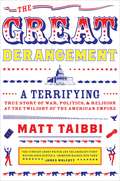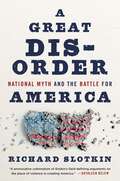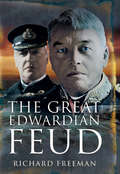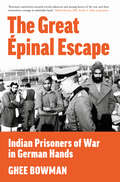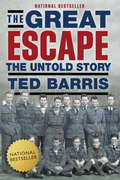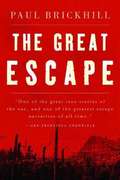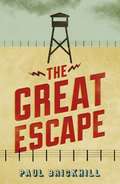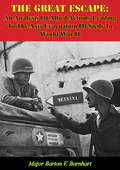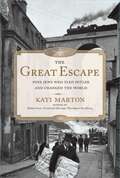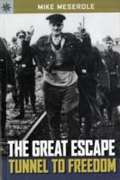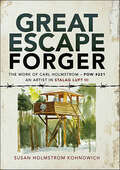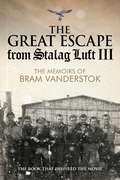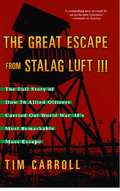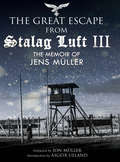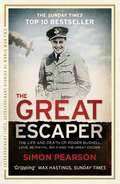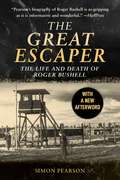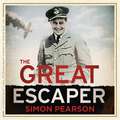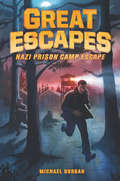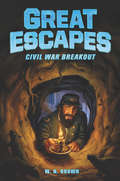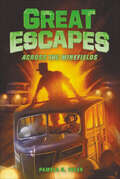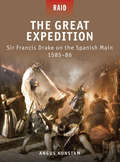- Table View
- List View
The Great Derangement: A Terrifying, True Story of War, Politics, and Religion at the Twilight of the American Empire
by Matt TaibbiIn describing the post-9/11 era, Taibbi ended up vomiting demons in an evangelical church in Texas, riding the streets of Baghdad in a convoy to nowhere, following a pork trail through Congress, and falling into the rabbit hole of the 9/11 Truth Movement. He tells the story of this new American madness by inserting himself into four defining American subcultures: THE MILITARY, THE SYSTEM, THE RESISTANCE, and THE CHURCH. Together these four interwoven adventures paint a portrait of a nation dangerously our of touch with reality and manically searching for answers in all the wrong places.
A Great Disorder: National Myth and the Battle for America
by Richard SlotkinAs culture wars pit us against each other, A Great Disorder looks to the myths that have shaped American identity and reveals how they have brought us to the brink of an existential crisis.Red America and Blue America are so divided they could be two different countries, with wildly diverging views of why government exists and who counts as American. Their ideologies are grounded in different versions of American history, endorsing irreconcilable visions of patriotism and national identity.A Great Disorder is a bold, urgent work that helps us make sense of today’s culture wars through a brilliant reconsideration of America’s foundational myths and their use in contemporary politics. Famous for his trilogy on the Myth of the Frontier, Richard Slotkin identifies five myths, born of different eras, that have shaped our conception of what it means to be American: the myths of the Frontier, the Founding, the Civil War (which he breaks into two opposing camps, Emancipation and the Lost Cause), and the Good War, embodied by the multiethnic platoon fighting for freedom. His argument is that while Trump and his MAGA followers have played up a frontier-inspired hostility to the federal government and rallied around Confederate symbols to champion a racially exclusive definition of American nationality, Blue America, taking its cue from the protest movements of the 1960s, envisions a limitlessly pluralistic country in which the federal government is the ultimate enforcer of rights and opportunities. American history—and the foundations of our democracy—have become a battleground. It is not clear at this time which vision will prevail.
Great Educators of Three Centuries: Their Work and its Influence on Modern Education
by Frank Pierrepont GravesThis book offers great insight of the thoughts of renowned educators of past centuries, and it powerfully mediates such insight to today's educational practitioners.Frank Pierrepont Graves, American educator, lawyer Decorated Knight of Crown of Belgium, 1925; Officer Legion of Honor, French, 1937. Awarded Butler medal for educational administration, 1927; medal of Academy of Public Education, 1936; gold medal of Holland Society, 1937; American Ednl. Award (Associate Exhibitors), 1941.“I have felt that an account of the life and work of the men who, during the past three centuries, have introduced various innovations and reforms into modern education might contain interest and value for many who would never read a more comprehensive and unified production. I have, however, made some attempt as well to present the social setting of each reformer. Moreover, although the facts of biography are narrated somewhat at length, an effort has been made to eliminate everything that does not seem to have some bearing upon the contributions of the educator under consideration or upon the spread and permanence of his work. Such a treatment, I venture to hope, will prove of service to the general reader and to the student of educational origins whose time is limited. The volume may be used as a reference work, a reading circle book, or even as a text for classes that are not in condition to cope with the complexities of modern educational history. The worth of the book for any of these purposes has probably been heightened by a liberal quotation from the sources in the body of the text and the addition of supplementary readings at the end of each chapter.”
The Great Edwardian Naval Feud: Beresford's Vendetta against ‘Jackie' Fisher
by Richard FreemenThis is the story of the clash between two gigantic personalities in the early years of the twentieth century.On one side was Admiral Lord Charles Beresford. Physically strong, courageous and hot-headed, he was the most popular admiral in the navy. Addicted to the sound of his own voice, he drew crowds of thousands whenever he spoke in public. On the other side was the First Sea Lord, Admiral Sir John Fisher. Of humble origin, he had risen through hard work and genius to become the greatest naval reformer that Britain has ever known.Both men wished to be First Sea Lord. When the prize went to Fisher, Beresford determined to unseat him at any cost. He launched attacks in Parliament, he plotted with Unionist politicians, he leaked state secrets and he courted public opinion. As a popular public figure, no one dared act against him until he finally overstepped the mark and viciously hounded a rear-admiral out of his fleet.A Cabinet inquiry followed, sitting for fifteen days. Its five members listened to Beresfords incoherent account of his eight charges. In the end, they dismissed the charges, but failed to show any warm support for either man. Fishers resignation followed and Beresfords career came to an end.
The Great Épinal Escape: Indian Prisoners of War in German Hands
by Ghee BowmanOn 11 May 1944 – just four weeks before D-Day – 67 American heavy bombers dropped 168 tons of bombs on the sunlit French town of Épinal on the Moselle river. Unbeknownst to the aircrew of the ‘Mighty Eighth’, this was the temporary home of over 3,000 Indian prisoners of war, brought there by the occupying Germans a few months before, from camps across the Third Reich.The bombs pierced the camp wall in places, and the prisoners – many of whom had made escape attempts previously – grabbed food and clothes and headed off, dodging German bullets. They knew that the Swiss frontier was just 100 kilometres away to the south, and that, if they could cross the border, they would be safe. Having been inside for up to four years, they were eager to get home.For the next few weeks, the fields, mountains and forests of eastern France became the hiding place for hundreds of Hindus, Sikhs, Muslims and Gurkhas. By the end of June, a staggering figure of 500 had arrived and were being housed in camps in northern Switzerland by a nation with long experience of looking after those escaping from conflict.This was the largest successful escape of the Second World War.All of this took place just six weeks after the famous ‘Great Escape’ from Stalag Luft III. In that escape, 76 men got out, 50 were shot by the Gestapo, and just three (two Norwegians and a Dutchman) made it back to Britain. In contrast, the 500 Indian POWs who escaped from Epinal in that same season are completely unknown. No film has been made, no book written of this astonishing feat.Tracing the paths of 8 individuals who were at Epinal, this book tells the incredible true story of those 500 and the greatest escape of the Second World War.
The Great Escape: A Canadian Story
by Ted BarrisA unique retelling of WWII’s most dramatic escape, told through first-hand recollections of the soldiers who experienced it. On the night of March 24, 1944, 80 Commonwealth airmen crawled through a 336-foot-long tunnel and slipped into the forest beyond the wire of Stalag Luft III, a German POW compound near Sagan, Poland. The event became known as &8220;The Great Escape,&8220; an intricate breakout more than a year in the making, involving as many as 2,000 POWs working with extraordinary coordination, intelligence, and daring. Yet within a few days, all but three of the escapees were recaptured. Subsequently, 50 were murdered, cremated, and buried in a remote corner of the prison camp. But most don’t know the real story behind The Great Escape. Now, on the eve of its 70th anniversary, Ted Barris writes of the key players in the escape attempt, those who got away, those who didn’t, and their families at home. Barris marshals groundbreaking research into a compelling firsthand account. For the first time, The Great Escape retells one of the most astonishing episodes in WWII directly through the eyes of those who experienced it. Joint Winner of the Libris Award for Non-Fiction Book of the Year 2014Globe and Mail BestsellerToronto Star Bestseller
The Great Escape
by Paul BrickhillThey were American and British air force officers in a German prison camp. With only their bare hands and the crudest of homemade tools, they sank shafts, forged passports, faked weapons, and tailored German uniforms and civilian clothes. They developed a fantastic security system to protect themselves from German surveillance. It was a split-second operation as delicate and as deadly as a time bomb. It demanded the concentrated devotion and vigilance of more than six hundred men--every one of them, every minute, every hour, every day and night for more than a year. Made into the classic 1963 war film of the same name starring Steve McQueen, James Garner, and Richard Attenborough.
The Great Escape (W&N Military)
by Paul BrickhillThe famous story of mass escape from a WWII German PoW camp that inspired the classic film.One of the most famous true stories from the last war, The GREAT ESCAPE tells how more than six hundred men in a German prisoner-of-war camp worked together to achieve an extraordinary break-out. Every night for a year they dug tunnels, and those who weren't digging forged passports, drew maps, faked weapons and tailored German uniforms and civilian clothes to wear once they had escaped. All of this was conducted under the very noses of their prison guards. When the right night came, the actual escape itself was timed to the split second - but of course, not everything went according to plan...
The Great Escape (CASSELL MILITARY PAPERBACKS)
by Paul BrickhillThe famous story of mass escape from a WWII German PoW camp that inspired the classic film.One of the most famous true stories from the last war, The GREAT ESCAPE tells how more than six hundred men in a German prisoner-of-war camp worked together to achieve an extraordinary break-out. Every night for a year they dug tunnels, and those who weren't digging forged passports, drew maps, faked weapons and tailored German uniforms and civilian clothes to wear once they had escaped. All of this was conducted under the very noses of their prison guards. When the right night came, the actual escape itself was timed to the split second - but of course, not everything went according to plan...
The Great Escape: An Analysis Of Allied Actions Leading To The Axis Evacuation Of Sicily In World War II
by Major Barton V. BarnhartAs Allied armies advanced in North Africa, Allied leadership established Sicily as the next target. As the invasion unfolded, the Allies pushed Axis forces into northeastern Sicily where a well-organized evacuation moved over 100,000 Axis troops, with equipment, to the Italian mainland. The central research question is: Did an opportunity exist for the Allies to trap and compel the capitulation of Axis forces during the Sicily campaign? Analysis of the invasion decision, the planning cycle, and the operation resulted in several conclusions. First, strategic guidance adequately promoted successful planning. Second, operational planning was disjointed and lacked senior ground commander involvement. Finally, Generals Eisenhower and Alexander did not communicate to their field army commanders a campaign strategic vision or commander's intent, which led to two decisions that eliminated the possibility to trap Axis forces. Additionally, the newness of combined operational practices and differences in command relationships caused coordination problems that hindered operational responsiveness. Though Sicily was a tactical success, the Allies missed an opportunity to capture a substantial Axis force, which demonstrates the importance of commander's vision and intent, cultivating unity of command in an allied environment and preserving the ability to exploit favorable conditions with an eye toward operational goals.
The Great Escape: Nine Jews Who Fled Hitler and Changed the World
by Kati MartonThe “intensely gripping story” of John von Neumann, Leo Szilard, Arthur Koestler, and six other world-renowned Hungarian Jews who fled the Nazis (The Washington Post Book World).In this book, New York Times–bestselling author Kati Marton tells the stunning tale of nine men who grew up in Budapest’s brief Golden Age, then, driven from Hungary by anti-Semitism, fled to the West, especially to the United States, and changed the world. These nine men, each celebrated for individual achievements, were part of a unique group who grew up in a time and place that will never come again. Four helped usher in the nuclear age and the computer, two were major movie myth-makers, two were immortal photographers, and one was a seminal writer. From a Peabody Award–winning journalist and finalist for a National Book Critics Circle Award, The Great Escape is a groundbreaking, poignant American story and an important untold chapter of the tumultuous last century.“Describes the crossroads where art and politics meet, the perils of dictatorship and the horrors of war, all of it punctuated by the frantic struggle to create the atomic bomb. . . . Deserves a special place on bookshelves alongside Budapest 1900.” —The New York Times Book Review“By looking at these nine lives—salvaged, and crucial—Marton provides a moving measure of how much was lost.” —The New Yorker“[Marton has] a keen understanding of what it means to leave one’s country behind.” —The Seattle Times“A haunting tale of the wartime Hungarian diaspora. . . . Marton writes beautifully.” —Publishers Weekly (starred review)“Filled with a number of wonderful anecdotes.” —Chicago Sun-Times“An engrossing book.” —Library Journal
The Great Escape: The Longest Tunnel
by Mike MeseroleA spine-tingling, suspenseful true story of escape during World War II. Spring, 1943; Stalag Luft III, Germany: every prisoner in the Nazi camps had one thought in mind to get out. The organization was in place, with men digging hidden passageways and squads dispersing yellow sand in the middle of soccer scrimmages. Forgers worked to create false travel documents. Tailors stitched up civilian suits from blankets. Their goal? To break out of an escape-proof" German prison camp and raise havoc throughout the German countryside. The stakes were high, however: anyone caught would be executed. Author Mike Meserole keeps the tension high in this newly-written tale filled with daring and danger. Kids will hang on to every word.
Great Escape Forger: The Work of Carl Holmstrom—POW#221. An Artist in Stalag Luft III
by Susan Holmstrom KohnowichCarl Holmstrom’s superb artwork depicts life as a ‘kriegie’ in a unique manner. But, more than that, he spent the major part of his captivity in Stalag Luft III Prisoner of War Camp, famous for ‘The Great Escape’. The audacity of the 76 escapees was only matched by the callousness of the Nazis who murdered 50 after recapture. As well as skillfully recording camp life, Carl forged invaluable official documents. He also sketched his fellow prisoners and encouraged others to take up drawing as hobby. Remarkably he saved over 200 examples of his work by carrying them on the appallingly arduous 1945 winter march from Poland into Germany. Post war, Carl Holmstrom said, “The drawings were made during imprisonment and represent a sincere effort to portray to the American people and especially to the relatives of the prisoners, intimate glimpses of Kriegie life.” His words proved to be prophetic. An expansion of his earlier self-published Kriegie Life, this superb book honors Carl’s exceptional artistic gift. This book has strong claim to contain the finest collection of POW art to emerge from Nazi-occupied Europe.
The Great Escape from Stalag Luft III: The Memoirs of Bram Vanderstok
by Bram van der StokI am one of those lucky ones who survived the war, and I can remember my emotional experiences, and those of my friends, as if they had happened yesterday. For many of us the horror, the injustice, and the cruelty can never be forgotten or forgiven; but I have tried to write without too much bitterness - Bob van der Stok On the night of 24th March 1944, Bob van der Stok was number 18 of 76 men who crawled beyond the barbed wire fence of Stalag Luft III in Zagan, Poland. The 1963 film, The Great Escape, was largely based on this autobiography but - with van der Stok's agreement -filmmakers chose to turn his story into an Australian character name Sedgewick, played by James Coburn. His memoir sets down his wartime adventures before being incarcerated in Stalag Luft III and then - with extraordinary detail - describes various escape attempts which culminated with the famous March breakout. After escaping Bram van der Stok roamed Europe for weeks, passing through Leipzig, Utrecht, Brussels, Paris, Dijon and Madrid, before making it back to England. He reported to the Air Ministry and two months after escaping, on 30 May 1944 he returned to the British no.91 Squadron. In the following months he flew almost every day to France escorting bombers and knocking down V1 rockets. In August 1944 he finally returned to his home. He learned that his two brothers were killed in concentration camps after being arrested for resistance work. His father had been tortured and blinded by the Gestapo during interrogation. He had never betrayed his son.
The Great Escape from Stalag Luft III
by Tim CarrollThe true story of one of the most heroic feats of World War II...the daring prison camp breakout that inspired the classic film The Great Escape Stalag Luft III was one of the Germans' "escape-proof" prison camps, specially built by Hermann Göring to hold Allied troops. But on March 24, 1944, in a courageous attempt by two hundred prisoners to break out through a series of tunnels, seventy-six Allied officers managed to evade capture -- and create havoc behind enemy lines in the months before the Normandy Invasion. This is the incredible story of these brave men who broke free from the supposedly impenetrable barbed wire and watchtowers of Stalag Luft III -- and who played an important role in Allied intelligence operations within occupied Europe. The prisoners developed an intricate espionage network, relaying details of military deployment, bombings, and raids. Some of them were involved in other daring escape attempts, including the famous Wooden Horse episode, also turned into a classic film, and the little-known Sachsenhausen breakout, engineered by five Great Escapers sent to die in the notorious concentration camp on Hitler's personal orders. Tragically, fifty of those involved in the Great Escape were murdered by the Gestapo. Others were recaptured; only a few made it all the way to freedom. This dramatic account of personal heroism is a testament to their ingenuity and achievement -- a stirring tribute to the men who never gave up fighting. Includes eight pages of photographs and illustrations, excerpts from Göring's testimony during postwar investigations, and a list of the men who escaped.
The Great Escape from Stalag Luft III: The Memoir of Jens Müller
by Jens MüllerThe true story behind the real &“Great Escape&” from a World War II Nazi POW camp by the veteran Norwegian pilot who lived it. Jens Müller was one of only three men who successfully escaped from Stalag Luft III (now in Poland) in March, 1944—the break that later became the basis for the famous film The Great Escape. Together with Per Bergsland, another Norwegian POW, he stowed away on a ship to Gothenburg, Sweden. The escapees sought out the British consulate and were flown from Stockholm to Scotland. From there they were sent by train to London and shortly afterwards to &“Little Norway&” in Canada. Müller&’s book about his wartime experiences was first published in Norwegian in 1946 titled Tre kom Tilbake (Three Came Back). This new edition is the first English translation and will correct the impression—set by the film—that the men who escaped successfully were American and Australian. In a vivid informative memoir, Müller details what life in the camp was like and how the escapes were planned and executed, and tells the story of his personal breakout and success reaching RAF Leuchars in Scotland. &“The Great Escape from Stalag Luft III offers a fascinating look at the 1940s, recapturing the feel of both the war and postwar era.&” —The Daily News
The Great Escaper: The Life and Death of Roger Bushell - Love, Betrayal, Big X and The Great Escape
by Simon PearsonRoger Bushell was 'Big X', mastermind of the mass breakout from Stalag Luft III in March 1944, immortalised in the Hollywood film The Great Escape. Very little was known about Bushell until 2011, when his family donated his private papers - a treasure trove of letters, photographs and diaries - to the Imperial War Museum. Through exclusive access to this material - as well as fascinating new research from other sources - Simon Pearson, Chief Night Editor of The Times, has now written the first biography of this iconic figure. Born in South Africa in 1910, Roger Bushell was the son of a British mining engineer. By the age of 29, this charismatic character who spoke nine languages had become a London barrister with a reputation for successfully defending those much less fortunate than him. He was also renowned as an international ski champion and fighter pilot with a string of glamorous girlfriends. On 23 May, 1940, his Spitfire was shot down during a dogfight over Boulogne after destroying two German fighters. From then on his life was governed by an unquenchable desire to escape from Occupied Europe. Over the next four years he made three escapes, coming within 100 yards of the Swiss border during his first attempt. His second escape took him to Prague where he was sheltered by the Czech resistance for eight months before he was captured. The three month's of savage interrogation in Berlin by the Gestapo that followed made him even more determined. Prisoner or not, he would do his utmost to fight the Nazis. His third (and last escape) destabilised the Nazi leadership and captured the imagination of the world. He died on 29 March 1944, murdered on the explicit instructions of Adolf Hitler. Simon Pearson's revealing biography is a vivid account of war and love, triumph and tragedy - one man's attempt to challenge remorseless tyranny in the face of impossible odds.
The Great Escaper: The Life and Death of Roger Bushell
by Simon PearsonA Sunday Times bestseller, the real story behind the mastermind of the most famous breakout in history—The Great Escape. While the most famous images from the 1963 film The Great Escape include either a motorcycle or a ball—but definitely Steve McQueen—Richard Attenborough played the part of &“Big X,&” the British mastermind behind the greatest escape in history. Like the subject of the film, &“Big X&” was a real person. Roger Bushell was the mastermind of the mass breakout from Stalag Luft III in March 1944. Very little was known about Bushell until 2011, when his family donated his private papers to the Imperial War Museum. Through exclusive access to this material, as well as new research from other sources, Simon Pearson has written the first biography of this iconic figure. Born in South Africa in 1910, Roger Bushell was the son of a British mining engineer. On May 23, 1940, his Spitfire was shot down during a dogfight over Boulogne after destroying two German fighters. Over the next four years he made three escapes, coming within one hundred yards of the Swiss border during his first attempt. His third (and last escape) destabilized the Nazi leadership and captured the imagination of the world, forever immortalized by Hollywood. Simon Pearson's revealing biography is a vivid account of war and love, triumph and tragedy—and one man's attempt to challenge remorseless tyranny in the face of impossible odds.
The Great Escaper: The Life and Death of Roger Bushell (Extraordinary Lives, Extraordinary Stories of World War Two #5)
by Simon PearsonSUNDAY TIMES TOP 10 BESTSELLER 'This gripping biography... Pearson has done uncommonly well to unearth so much.' (Max Hastings, Sunday Times)Roger Bushell was 'Big X', mastermind of the mass breakout from Stalag Luft III in March 1944, immortalised in the Hollywood film The Great Escape.Very little was known about Bushell until 2011, when his family donated his private papers - a treasure trove of letters, photographs and diaries - to the Imperial War Museum. Through exclusive access to this material - as well as fascinating new research from other sources - Simon Pearson, Chief Night Editor of The Times, has now written the first biography of this iconic figure. Born in South Africa in 1910, Roger Bushell was the son of a British mining engineer. By the age of 29, this charismatic character who spoke nine languages had become a London barrister with a reputation for successfully defending those much less fortunate than him. He was also renowned as an international ski champion and fighter pilot with a string of glamorous girlfriends. On 23 May, 1940, his Spitfire was shot down during a dogfight over Boulogne after destroying two German fighters. From then on his life was governed by an unquenchable desire to escape from Occupied Europe.Over the next four years he made three escapes, coming within 100 yards of the Swiss border during his first attempt. His second escape took him to Prague where he was sheltered by the Czech resistance for eight months before he was captured. The three months of savage interrogation in Berlin by the Gestapo that followed made him even more determined. Prisoner or not, he would do his utmost to fight the Nazis. His third (and last escape) destabilised the Nazi leadership and captured the imagination of the world.He died on 29 March 1944, murdered on the explicit instructions of Adolf Hitler.Simon Pearson's revealing biography is a vivid account of war and love, triumph and tragedy - one man's attempt to challenge remorseless tyranny in the face of impossible odds.
The Great Escaper: The Life and Death of Roger Bushell (Extraordinary Lives, Extraordinary Stories of World War Two #5)
by Simon PearsonSUNDAY TIMES TOP 10 BESTSELLERThe thrilling true story of the real Great Escape, published to coincide with the 70th anniversary of the escape.'This gripping biography... Pearson has done uncommonly well to unearth so much.' (Max Hastings, Sunday Times)Roger Bushell was 'Big X', mastermind of the mass breakout from Stalag Luft III in March 1944, immortalised in the Hollywood film The Great Escape.Very little was known about Bushell until 2011, when his family donated his private papers - a treasure trove of letters, photographs and diaries - to the Imperial War Museum. Through exclusive access to this material - as well as fascinating new research from other sources - Simon Pearson, Chief Night Editor of The Times, has now written the first biography of this iconic figure. Born in South Africa in 1910, Roger Bushell was the son of a British mining engineer. By the age of 29, this charismatic character who spoke nine languages had become a London barrister with a reputation for successfully defending those much less fortunate than him. He was also renowned as an international ski champion and fighter pilot with a string of glamorous girlfriends. On 23 May, 1940, his Spitfire was shot down during a dogfight over Boulogne after destroying two German fighters. From then on his life was governed by an unquenchable desire to escape from Occupied Europe.Over the next four years he made three escapes, coming within 100 yards of the Swiss border during his first attempt. His second escape took him to Prague where he was sheltered by the Czech resistance for eight months before he was captured. The three months of savage interrogation in Berlin by the Gestapo that followed made him even more determined. Prisoner or not, he would do his utmost to fight the Nazis. His third (and last escape) destabilised the Nazi leadership and captured the imagination of the world.He died on 29 March 1944, murdered on the explicit instructions of Adolf Hitler.Simon Pearson's revealing biography is a vivid account of war and love, triumph and tragedy - one man's attempt to challenge remorseless tyranny in the face of impossible odds.(P) 2023 Hodder & Stoughton Limited
Great Escapes #1: Nazi Prison Camp Escape (Great Escapes #1)
by Michael BurganAre you ready for some of the most exciting, death-defying escape stories ever told? Perfect for fans of the I Survived series, the first installment in a brand-new, edge-of-your-seat series based on real events! In spring 1942, Royal Air Force pilot Bill Ash’s plane was shot down by Germans, who captured and eventually brought him to Stalag Luft III, a notorious camp for prisoners of war. The Germans boasted that the camp—which was isolated, heavily guarded, and surrounded by wire fences—was escape proof. But Ash was ready to prove them wrong. He, along with other POWs, would dig tunnels, hide in shower drains, or jump on trucks—all in the name of freedom. Because resisting the Germans was their mission, and escaping was their duty.From reluctant reader to total bookworm, each book in this page-turning series—featuring fascinating bonus content and captivating illustrations—will leave you excited for the next adventure!
Great Escapes #3: Civil War Breakout (Great Escapes #3)
by W. N. BrownAre you ready for some of the most exciting, death-defying escape stories ever told? The third installment in the unputdownable Great Escapes series is here—perfect for fans of the I Survived series!Civil War, 1863. Virginia. Union soldiers Colonel Thomas Rose and Major A. G. Hamilton were captured by the Confederate Army and taken to Libby Prison—one of the most horrific prisons ever run.Few ever made it out of the overcrowded, vermin-infested prison alive.But neither fear, nor darkness, nor squealing rats could keep Rose and Hamilton from freedom. They and other POWs would fight against the odds to attempt the largest prison escape in American history. From reluctant reader to total bookworm, each book in this page-turning series—featuring fascinating bonus content and captivating illustrations—will leave you excited for the next adventure!
Great Escapes #6: Across the Minefields (Great Escapes Ser. #6)
by Pamela D. Toler W. N. BrownAre you ready for some of the most exciting, death-defying escape stories ever told? The sixth installment in the Great Escapes series is here—perfect for fans of the I Survived series!June, 1942—Libya. Free French Officer Susan Travers was one of the few women on the frontlines in Africa during World War Two. After the Germans surrounded the military camp of Bir Hakeim, a shocking order was issued. The French troops were going to break out in the middle of the night—crossing through dangerous minefields and enemy territory—to reach their British allies. And Officer Travers would be leading the charge.With the lives of thousands of military men at risk, stakes were high. But Officer Travers didn’t face rejection and break gender barriers to back down now. Her country needed her to fight. And win. For reluctant readers to total bookworms, this gripping historical fiction story—featuring fascinating bonus content and captivating illustrations—will leave you eager to read the whole series!
Great Escapes of World War II
by George SullivanThe true stories of 7 dating escapes by prisoners of war during WWII including Colditz Castle, Auschwitz, Stalag Luft III, and more.
The Great Expedition: Sir Francis Drake on the Spanish Main 1585/86
by Angus Konstam Peter DennisIn 1585, the English launched a pre-emptive strike against Spain, by attacking her New World colonies. Led by Sir Francis Drake, in command of 21 ships and 1,800 soldiers, the expedition struck first at the Canary Islands, then attacked the city of Santo Domingo and the treasure port of Cartagena. Frequently outnumbered, Drake's soldiers won an series of spectacular victories and, laden with treasure, sailed home to a hero's welcome.
